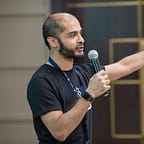Embracing Serendipitous Emergence vs. Outcome Certainty
By Aman Merchant, Co-Founder & Chief Provocateur of Radicle
The power of catalytic moments.
Mahatma Gandhi freeing India from colonialism.
John F Kennedy’s putting a man on the moon.
Martin Luther King’s envisioning a more equal America.
COVID catalyzing the shift to a digital (maybe more caring) world.
The power of one. Doing something. Anything.
In the increasingly socially conscious world we live in, the role of social enterprises is changing. And what they’re changing as a result. No longer confined to the edges. Becoming part of the mainstream conversation in many economies. And with that, the power of those catalytic moments, shifting policies, industries & economies, mindsets & behaviors. Not just left to the big boys with big wallets, wanting to become socially engaged.
Social enterprises have the potential to change entire industries as they exert influence in three ways: by raising the possible; by raising the desirable; and by raising the acceptable.
We’ve seen globally how the most agile organizations run the most number of experiments — Amazon, Google, or Tesla. The power of experiments, combining with intentional leadership, is a catalytic converter.
And faced with the wicked problems we do today, magnified by COVID, social enterprises are the n=1 ‘engine’ for running experiments across the domains that matter — education, climate change, agriculture, poverty, health, and more. Continuous testing is not a novel concept but the social enterprises provide stakeholders with a powerful ally to do this, with the DNA of social enterprises driven by the need to enact social change in a profitable manner. And that need requires them to work in ways that haven’t often been explored before. Or explored often enough. And with more intentionality behind it, rather than a corporate initiative.
But the idea of experimentation on its own isn’t enough. Intentional leadership particularly focused on working with a diverse range of allies (likely and unlikely), is crucial in ensuring that the complexity posed by the typology of wicked problems is addressed and attacked using a multi-dimensional lens, one that has the patience for the principle of “serendipitous emergence” versus that of outcome certainty. Even if the serendipity is built into the organizational setup of the experiments, led by social enterprises. It goes back to the concept of active listening, which has the generosity to let possibilities in versus being held back by the tyranny of biases consciously or unconsciously held by vested interests. And embeds the need to feel comfortable with ambiguity in the face of fluidity. And backed by double-loop learning rather than the traditional and ‘easier’ single-loop learning model, which was perhaps more relevant for the 19th century when the exponential change wasn’t the order of the day.
Dan Sullivan has said that the eyes only see and the ears only hear what the mind wants it to. By attuning the mind to the principle of serendipitous emergence, and letting actors like social enterprises be the captains of these new vessels, we give ourselves the freedom and opportunity of unleashing experiments that could provide us wayfaring insights and intelligence into different, resilient and (hopefully) better pathways for solving wicked problems.
At the end of the day, we need more servants and fewer heroes. More curiosity and less knowing.
